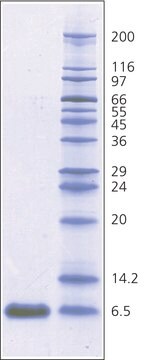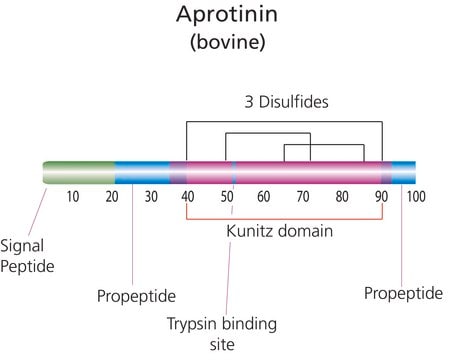A6103
Aprotinin bovine
recombinant, expressed in Nicotiana (tobacco), ≥5 TIU/mg protein, ≥98% (SDS-PAGE)
Synonym(s):
BPTI, Basic pancreatic trypsin inhibitor, Kallikrein-trypsin inactivator, Kunitz protease inhibitor
About This Item
Recommended Products
biological source
bovine
Quality Level
recombinant
expressed in Nicotiana (tobacco)
product line
BioUltra
Assay
≥98% (SDS-PAGE)
form
powder
specific activity
≥5 TIU/mg protein
mol wt
~_6.5 kDa
technique(s)
inhibition assay: suitable
solubility
0.85% sodium chloride: 5 mg/mL
UniProt accession no.
storage temp.
2-8°C
Gene Information
cow ... PTI(404172)
Looking for similar products? Visit Product Comparison Guide
Related Categories
Biochem/physiol Actions
Unit Definition
Preparation Note
Storage Class Code
11 - Combustible Solids
WGK
WGK 1
Flash Point(F)
Not applicable
Flash Point(C)
Not applicable
Personal Protective Equipment
Certificates of Analysis (COA)
Search for Certificates of Analysis (COA) by entering the products Lot/Batch Number. Lot and Batch Numbers can be found on a product’s label following the words ‘Lot’ or ‘Batch’.
Already Own This Product?
Find documentation for the products that you have recently purchased in the Document Library.
Customers Also Viewed
Protocols
Objective: To standardize a procedure for the enzymatic assay of Aprotinin.
Our team of scientists has experience in all areas of research including Life Science, Material Science, Chemical Synthesis, Chromatography, Analytical and many others.
Contact Technical Service







